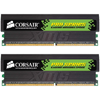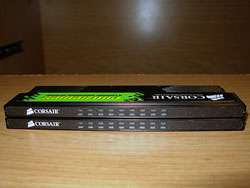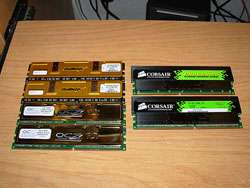- Qualcomm Launches Snapdragon 4 Gen 2 Mobile Platform
- AMD Launches Ryzen PRO 7000 Series Mobile & Desktop Platform
- Intel Launches Sleek Single-Slot Arc Pro A60 Workstation Graphics Card
- NVIDIA Announces Latest Ada Lovelace Additions: GeForce RTX 4060 Ti & RTX 4060
- Maxon Redshift With AMD Radeon GPU Rendering Support Now Available
Corsair TWINX2048-3500LLPRO CAS2

Corsair have just launched what they call the fastest ASUS compatible DDR1 memory on the market. At PC3500 and CAS2, these 1GB sticks soar past the competition. Let’s see just how overclockable they are, and see how far we can push them while keeping our beloved CAS2.
Page 2 – Overclocking
This joint effort started quite a while ago, and ASUS have been working hard to make sure the modules work pefect in the two boards listed. The engineers at ASUS have been using the memory in their lab for characterization, performance optimization, BIOS engineering and so forth. This should prove some awesome overclocking ability, to say the least.
Obviously, Corsair did their part as well. As ASUS found better ways to do things, Corsair modified their memory so that they could get the desired performance. They had one huge goal in mind, and that was to have the memory work flawlessly at CAS2.
My immediate goal with these modules, was to see how far I could go in pushing more MHz into them, while keeping the CAS latency of 2. My secondary goal was to see if they could reach DDR500 speeds, which is a very healthy jump from the stock DDR438 speeds.
Before any overclocking, I ran looped MemTest 1.60 for 15 hours to test for errors at stock speeds of DDR438 (2.19GHz). After the tests came back clean, I got right to work. It was not too long before I figured out that the CAS of 2 would not work beyond the stock 219HTT, as even 220HTT brought on many errors in MemTest.
After spending about 8 hours this past Saturday overclocking, here are my final results:
- 219HTT 2-3-2-6 @ 2.8v
- 230HTT 2.5-3-3-6 @ 2.8v
- 240HTT 2.5-3-3-6 @ 2.8v
- 250HTT 2.5-3-3-6 @ 2.8v
- 255HTT 2.5-3-3-6 @ 2.8v
- 257HTT 2.5-3-3-6 @ 2.8v
- 260HTT 3-3-2-6 @ 2.8v
All of the settings above proved error free for two runs of tests #5 and #8 in MemTest. They also were completely stable during the memory related and gaming benchmarks. The final result at 260HTT was error free after an 8 hour loop of MemTest.
One thing I found during testing, was that this memory doesn’t respond that well to extra voltage, which is why all the results were accomplished with 2.8. Heading up to 2.9 or 3.0 didn’t change anything performance wise, and beyond that would begin to give errors during memtest.
Finally, all results before the 250HTT mark were done without cooling of any kind. To get 250HTT and higher, I mounted a 120mm fan to help things along, and it did apparently help a fair bit. I am pleased with the overclocking results here. They proved completely stable at DDR 520 (PC 4160) speeds, with fantastic timings.
To benchmark these modules, we used the usual slew of programs and games. For straight out memory testing, we used Lavalys’ EVEREST Ultimate Edition, and also SiSoftware’s SANDRA 2005. For games, we used the classics: Half-Life 2 and Doom III.
For our memory benchmarks, we used all of our successful overclocked settings. For our gaming benchmarks, we only used a few select ones since playing the same level 7 times in a row get’s tedious fast :)
We have also included a few comparison benchmarks, which use these settings:
- Corsair PC3500LL (2.5-3-3-6, 2.8) 2*1024MB
- OCZ PC4000 Gold (2.5-3-3-8, 2.8) 2*1024MB
- Crucial PC4000 Ballistix (3-4-4-8, 2.7) 2*512MB
|
|
Support our efforts! With ad revenue at an all-time low for written websites, we're relying more than ever on reader support to help us continue putting so much effort into this type of content. You can support us by becoming a Patron, or by using our Amazon shopping affiliate links listed through our articles. Thanks for your support!







